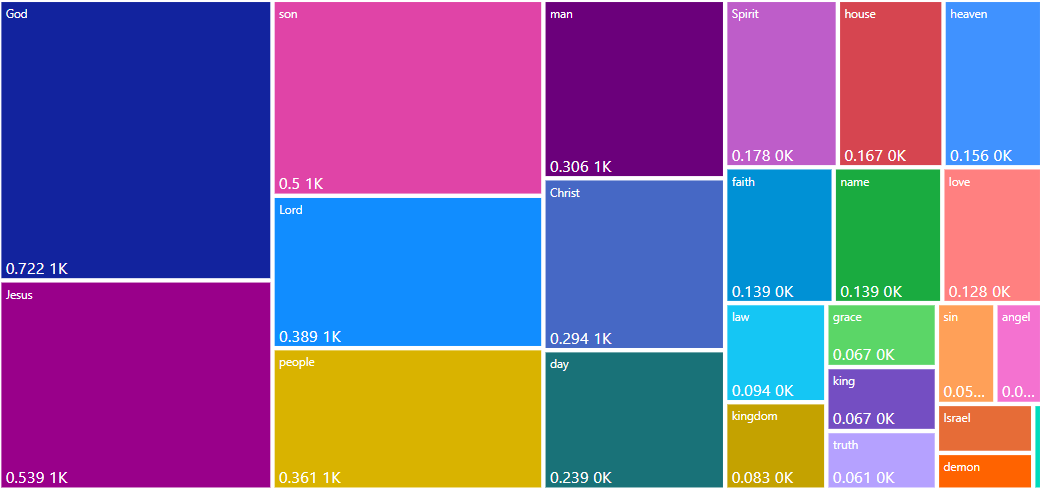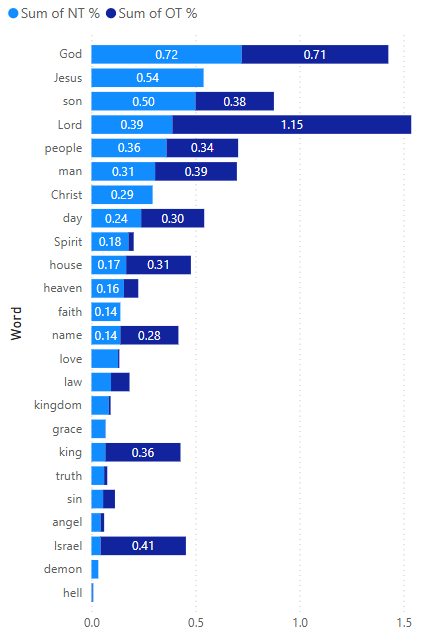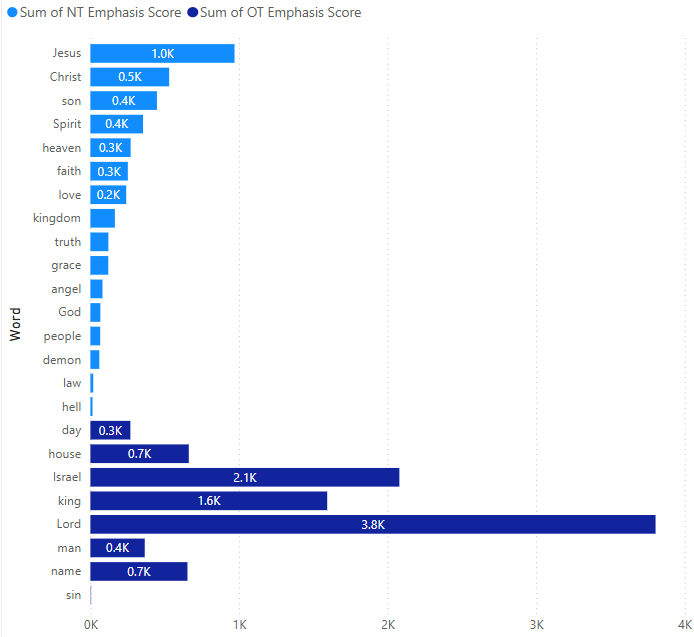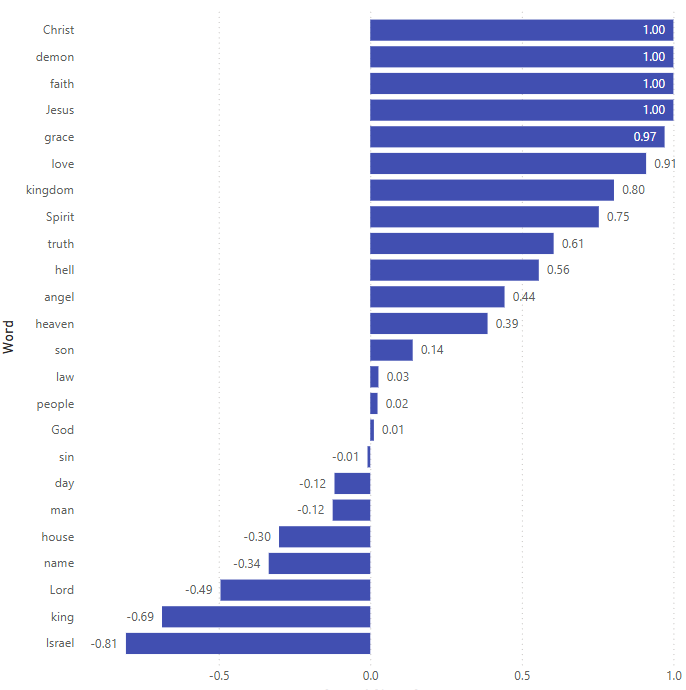How important is each word in the Bible, really?
Click on each image below for a full view
I’ve always loved data analytics; in fact it’s a large portion of my job. I love spreadsheets, visualization, learning. The Bible isn’t always the best place to hone those skills, but I thought, why not take a stab at reviewing how word choices have changed between the Old and New Testaments. There are a lot of caveats here, and this analysis is in no way scientific, but I thought the results gave a good picture of how the tone of the writings has changed – and the focus of what we study has evolved.
But there is another catch: just because a word shows up a lot doesn’t mean it’s central to the New Testament. And just because a word is rare doesn’t mean it’s not pulling theological weight.
So, I created a basic formula that does two things:
- Accounts for frequency – how often a word appears.
- Accounts for direction – whether it’s mostly OT, NT, or balanced.
How the Scoring Criteria Work:
This is not a bullet proof scientific experiment, it’s to illustrate how changes have occurred in tone between books.
Step 1: Percent of Total Words
We start by asking: out of all the words in the Old and New Testaments, what percent does this word take up?
Example:
“Love” = 0.013% of OT, 0.128% of NT
So, clearly more of a New Testament vibe.
Skew Score
We then calculate how lopsided the usage is. This is the Skew Score:
Skew Score = (NT% – OT%) / (NT% + OT%)
So a word used only in the NT gets a score of +1, only in the OT = -1, and evenly split = 0.
It’s like a compass:
- Positive = NT-focused
- Negative = OT-heavy
- Zero = Bible-wide
Step 3: Total Frequency
Next, we just add the OT and NT counts. More appearances = heavier theological presence.
Step 4: Emphasis Score
This is the money number. We multiply Total Frequency × Absolute Skew Score:
Emphasis Score = Total Frequency × |Skew Score|
Why?
- If a word shows up 1,000 times but is split evenly, the emphasis score is near 0.
- If it shows up 1,000 times and is used only in the New Testament, the score is 1,000.
- The more frequent and more one-sided the usage, the more we say it defines that part of scripture.
Step 5: Split It Up by Testament
We finally break that emphasis into NT Emphasis Score and OT Emphasis Score depending on which side the skew favors. That way you can say “Wow, ‘grace’ really is a New Testament signature,” or “Yup, ‘Israel’ basically lives in the Old Testament.”
Why This Works
- It balances volume and location.
- It avoids overvaluing common but evenly distributed words (like “man”).
- It spotlights signature concepts. You get to say, “This word owns the NT,” backed by math.
The Nitty Gritty Details
Click on each image for full details
Some Casual Observations
These are some of the opinions of what these word counts might show us – how the authors have changed the tone of our beliefs. These are just my observations, and maybe you will have much different ones.
The Old Testament Is Obsessed with “Lord”
With 7,000 uses in the OT (and just 700 in the NT), “Lord” isn’t just a word—it’s a controlling presence. It screams covenant language. “The Lord said,” “The Lord delivered,” “The Lord smote.” The emphasis score is off the charts on the OT side. God is not so much a concept there—he’s the guy in charge, with a booming voice and very strong opinions about idols.
In the NT, “Lord” shifts from Yahweh to Jesus. It’s more title than thunderbolt. Still used, but the emphasis is diffused. Less smoke and fire, more foot washing.
“Jesus” Doesn’t Exist Until He Does—Then He Dominates
Zero times in the OT. Not even a whisper (not by name, anyway). But in the NT? Nearly 1% of the entire New Testament is just the name Jesus. That’s bonkers. For a single person’s name, that’s headline-level emphasis.
And with a Skew Score of 1.000, the data agrees: the NT is a Christ-centered document from start to finish.
“Israel” Lives in the Past
You can feel the NT slowly pulling away from the national identity of “Israel.” OT: 2,500 times. NT: just 80. That’s a 30x drop. It’s not just a word frequency—it’s a theological pivot.
In the NT, “Israel” becomes symbolic. Sometimes it’s a people, sometimes a metaphor, sometimes a warning. But it’s no longer the main character. The Church takes that role.
“Grace” and “Faith” Are the NT’s Love Letters
- Grace in OT? Barely a blip.
- In NT? 120+ times.
Same story with Faith—Paul can’t shut up about it. It’s his lifeline, his lens, his answer to the Law. This isn’t a vocabulary difference. It’s a paradigm shift.
Old Covenant: obedience, sacrifice, survival.
New Covenant: grace, faith, transformation.
The New Testament’s Theological Center Is a Cluster
Let’s call it the NT Core Four:
- Jesus
- Faith
- Grace
- Love
These four don’t just show up—they cluster together. They define the NT’s voice: relational, redemptive, and slightly allergic to the temple system.
“Law” Lingers, But Its Power Is Eroding
“Law” is still there in the NT, but it’s under fire. Paul reframes it. Jesus challenges it. The word appears 540 times in the OT and 170 in the NT, but the tone has changed entirely. The Law was once the main event. In the NT, it’s the opening act that gets booed off stage by a guy preaching grace to Gentiles.
“Hell” and “Demon” Are Small But Loud
Their frequencies are low, but their punch is heavy:
- “Hell”: ~13 NT uses, all Jesus, all heavy.
- “Demon”: ~60 NT uses, mostly in Gospels.
These aren’t background terms. They’re shocks to the reader. Think less “theme,” more “trigger.”
“Kingdom” Is Jesus’ Favorite Word That Nobody Understands
He uses it constantly—150 times in the NT—but never defines it like a good theologian would. Instead, he compares it to yeast, mustard seeds, buried treasure. Which is super helpful, thanks.
But here’s the kicker: it’s used more in the NT than OT, despite kingship being a literal institution in the OT. That’s a theological juke: earthly kings get dethroned, and the Kingdom of Heaven takes the stage.
“Angel” Shows Up to Deliver Messages, and They are Always Punchy
Mentioned in both testaments, with slightly more OT love, but still prominent in NT. Not central, but unforgettable. Every time an angel appears, someone’s world changes. I like to think of them like an IRS agent showing up to deliver papers, they are always fast and unforgettable.
That’s a lot of info, and to different people these numbers may mean different things. I just wanted to select a few words to show how the dynamic changes throughout the testaments, and the way we worship, appreciate, and dedicate our lives have changed as well. These are just my opinions, and I hope you are able to form some new ones as well. Thank you for reading and make sure you say a prayer tonight.













0 Comments